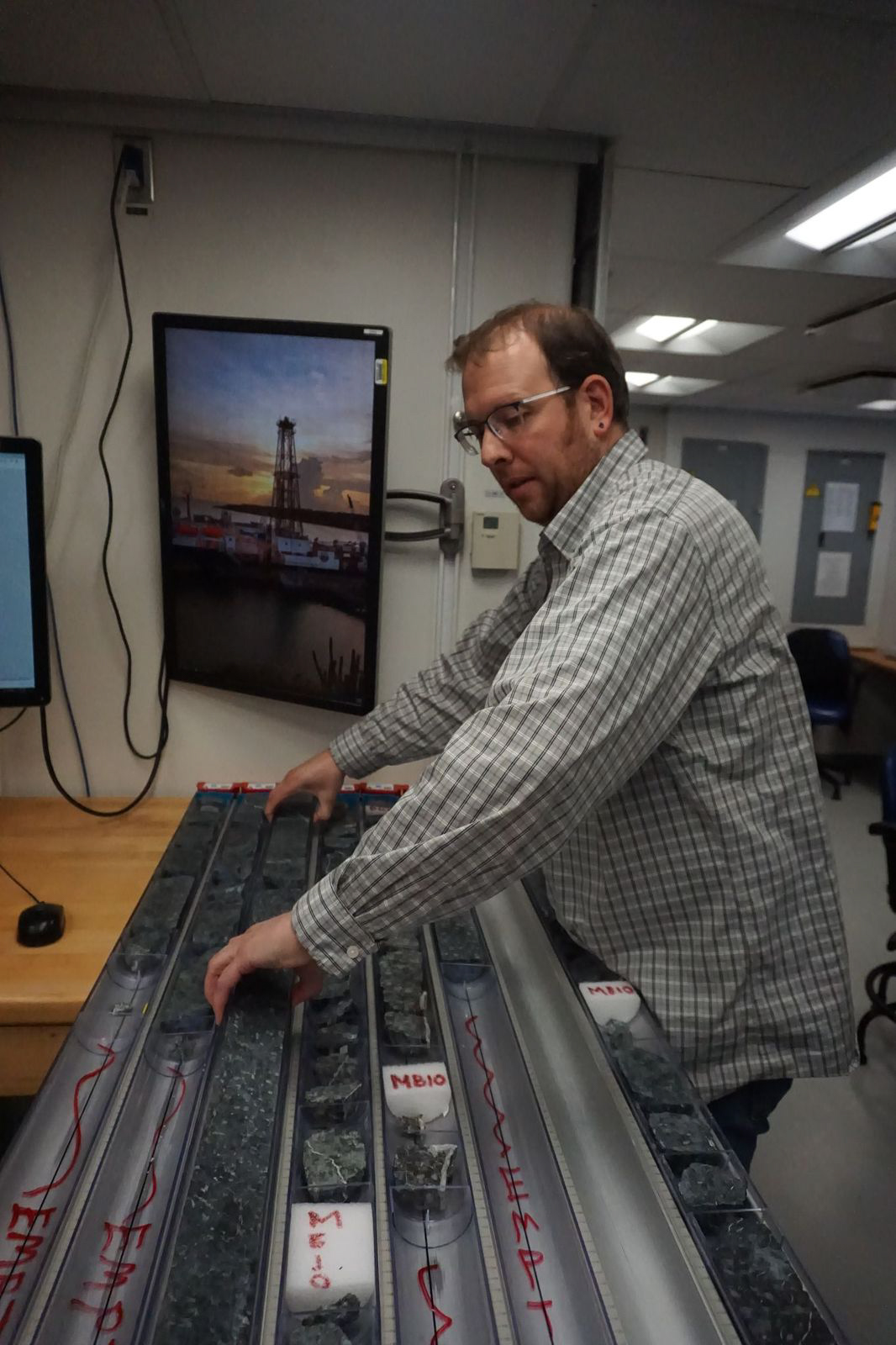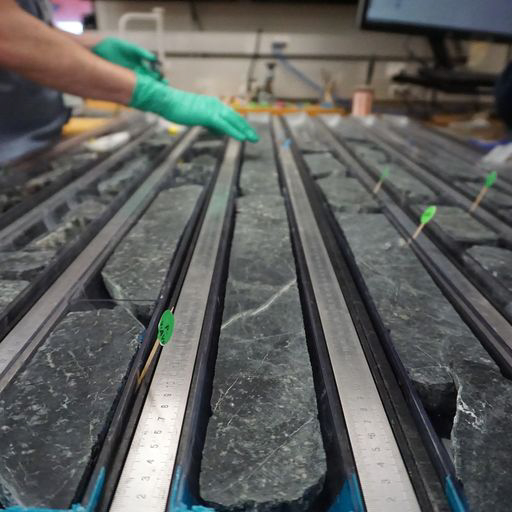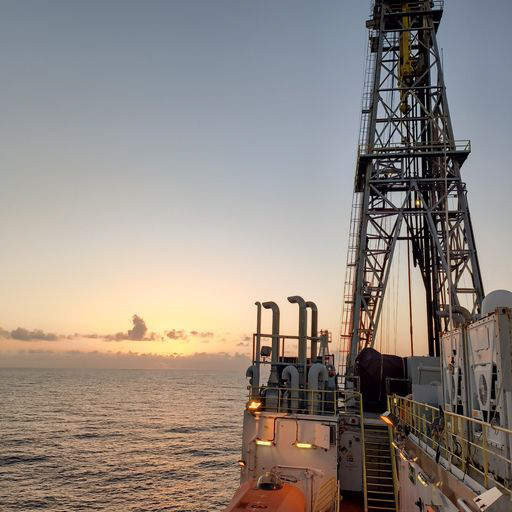Exploring Frontiers: USM Geologist Among Scientists Aboard Historic Ocean Drilling Expedition
Tue, 07/18/2023 - 10:19am | By: Ivonne Kawas

Dr. Jeremy Deans prepares halved cores of serpentinized peridotite for analysis in the core lab of the scientific drilling ship JOIDES Resolution. Photo credit: Lesley Anderson
Dr. Jeremy Deans, a geologist at The University of Southern Mississippi (USM), got to experience the life of a deep ocean explorer as he was among 110 scientists, technicians, staff, and crew members aboard the research vessel JOIDES Resolution for a two-month drilling expedition into the Atlantis Massif, Mid-Atlantic Ridge, Atlantic Ocean, to uncover insights from the Earth’s mantle.
Since the discovery of the “Lost City” chimney field at Atlantis Massif in 1993, JOIDES Resolution, the flagship vessel of the International Ocean Discovery Program (IODP), has made three additional expeditions to the area. The most recent expedition embarked from the port in Ponta Delgada, Azores, in Portugal and initially aimed to deepen a previously drilled hole of gabbro, which makes up the majority of the oceanic crust, and a shallower hole in peridotite, which makes up the majority of Earth as part of the mantle.
However, a groundbreaking milestone occurred. As scientists drilled the shallow hole, ultimately, they were able to drill deep into a 1,300-meter-hole to collect core sample of rock known as serpentinized peridotite from the Earth's upper mantle. This broke the record set in 2003 of a depth of 200 meters.
“As a geologist and member of the drilling expedition, this achievement fills me with pride as it is a testament to the dedication and perseverance of our scientific team and crew,” said Dr. Jeremy Deans, Associate Professor of Geology at USM. “This was my fourth time participating in a drilling expedition, and it was just as memorable as the first.”
This milestone holds profound implications for geological research and will help scientists gain valuable insights into the processes and dynamics occurring deep within the Earth.
“While rocks of this nature have been studied previously, what sets this apart is the substantial amount and variety of the samples that were recovered,” said Dr. Deans. “While not the world's deepest hole, this accomplishment holds immense significance due to the specific peridotite formations that were retrieved. Studying these rocks will help scientists gain valuable insights into the processes and dynamics occurring deep within the Earth.”
Dr. Deans explains that most of the Earth's composition is made of the mantle, a rock known as peridotite. Usually, the mantle is covered beneath the Earth's crust, making these rocks inaccessible and hidden from direct study. There are certain unique areas where scientists can examine peridotite, but they have undergone tectonic placement, which means that their original characteristics have been altered. Therefore, recovering intact sections of the mantle enables scientists to study primary mantle processes that were previously not accessible or altered.

Halved core sections of serpentinized peridotite from IODP Hole U1601C, Atlantis Massif, Mid-Atlantic Ridge, Atlantic Ocean, the deepest hole in serpentinized peridotite in the world. Photo credit: Lesley Anderson
“Since we were able to recover parts of the mantle in place, we used this cored section to study some of the primary mantle processes not easily studied elsewhere,” said Dr. Deans. “There was some alteration of the primary rock samples in the form of serpentinite. Serpentine reactions can form hydrogen and methane, which are easily metabolized by microbes, which may be the location of early life on Earth. These reactions also strip elements out of the rocks and precipitate others, leading to large chemical and heat exchanges between seawater and rocks.”
Despite the challenges and long hours of work, the scientific team demonstrated an unwavering commitment to advancing scientific knowledge.
“Working on board the research vessel presented its own set of challenges, with grueling 12-hour shifts and no weekends for two months,” said Dr. Deans. “The benefits of immersing ourselves in this study site for an extended period became evident and kept us motivated.”
In the past, Dr. Deans had sailed as a structural geologist, whereas on this expedition he served as a physical properties and downhole logging specialist.
“As a downhole logging specialist, I was in charge of managing and interpreting downhole petrophysical tools that measure physical properties of the rocks in the borehole,” said Dr. Deans. “Physical properties of these rocks include density, porosity, natural gamma radiation from the rocks, seismic velocity, and magnetic properties.”

The drilling derrick of the scientific drilling ship JOIDES Resolution during sunset. Photo credit: Fengping Wang
The project brought together a diverse group of scientists from various IODP member countries, including the United States, United Kingdom, Japan, France, Germany, China, India, and Australia, who all had to submit proposals that underwent rigorous review, followed by an invitation process.
“It is incredible to think about the wealth of knowledge I was able to obtain by engaging in discussions and sharing insights with the invited leading experts and scientists,” said Dr. Deans. “Thanks to the guidance of my peers and the vast amount of information I absorbed during this expedition, I have enhanced my understanding of these unique rock formations.”
The scientific party involved will study the rock samples and will make their findings public. The IODP will oversee the initial analysis and publication of technical reports via their website, ensuring the information is readily available for scientific discourse and further studies. Dr. Deans will start his post-expedition work this fall with an incoming graduate student and undergraduate students in coordination with other shipboard scientists.
“I’m filled with enthusiasm for the exciting work that lies ahead,” said Dr. Deans. “This milestone in drilling depths has set a new benchmark for our field and has inspired us to explore new frontiers.”
It is important to acknowledge that due to the declining in funding for oceanic drilling programs, the National Science Foundation (NSF) announced that it would retire its flagship JOIDES Resolution drilling vessel this year.
“We are trying to get NSF and other science support agencies to reassess funding models to be able to get back to scientific ocean drilling,” said Dr. Deans. “This is a significant setback for the scientific community, who will not only be losing the opportunity to undertake scientific ocean drilling but also the collective knowledge and expertise that we’ve been able to obtain.”
About the JOIDES Resolution
The JOIDES Resolution is a world-class scientific drilling ship renowned for its contributions to oceanic research. As part of the International Ocean Discovery Program (IODP), it plays a crucial role in advancing our understanding of the Earth’s geological history and processes. Visit JOIDES Resolution or the IODP for more information.